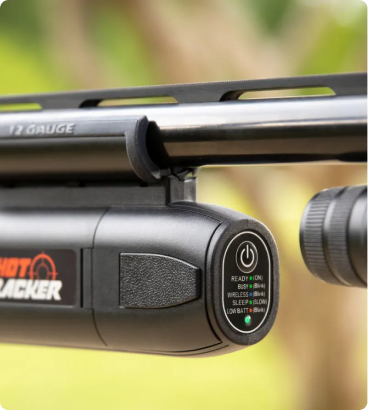Point of Aim vs. Point of Impact – How ShotTracker Helps You Align Yor Shot
In shotgun shooting, hitting the target consistently isn’t just about reaction and swing – it’s also about where you aim versus where your shot actually goes. The relationship between Point of Aim (POA) and Point of Impact (POI) is critical. POA is where you intend for your shot to go (for instance, you might be pointing right at the clay or slightly ahead of it), while POI is where the pattern of pellets actually strikes. Ideally, a well-fitted shotgun and proper technique mean your POA and POI coincide. However, if they don’t, a shooter can miss even if their aim was “correct.” Here’s how understanding POA vs. POI, and using ShotTracker’s data, can tighten your accuracy.
Why POA and POI Can Differ
There are a few common reasons your shotgun’s POI might not match your POA. One is shotgun fit – if the shotgun’s stock doesn’t fit your build, you might be unknowingly aiming high or low. For example, a shotgun that’s shooting high will have a POI above your POA; many trap shooters actually prefer a slightly high-shooting gun to see the target, but for most applications you want them aligned. Flinching or improper mount can also throw off POI. If a shooter lifts their head off the stock at the last instant, even a perfectly fitted gun will shoot high because the rear “sight” (the shooter’s eye) moved. Cross-dominance (when your dominant eye is opposite your shooting hand) can pull shots to one side. In short, inconsistencies or equipment issues often show up as a POA/POI mismatch.
Diagnosing Alignment with ShotTracker
Traditionally, to check POA vs. POI, a shooter might shoot at a paper patterning target to see where the pellets hit relative to the aim point. ShotTracker simplifies this process in the field. The device’s sensors and camera can determine where your muzzle was aimed and where the shot went. For instance, during practice you might feel like you were right on target with a crossing clay (your POA was correct), yet you miss behind it. The ShotTracker replay can show the path of your shot cloud and confirm if it was indeed trailing the target (the POI was behind). If you repeatedly see a pattern – say all your misses on straight incoming targets are slightly left – that is a clue your POA/POI alignment needs adjustment (perhaps your gun is shooting left for you, or you’re consistently pulling). By having this data, you diagnose the problem faster. It’s objective evidence replacing guesswork. Instead of “I think I’m always left,” you know from the data that you are.
Making Adjustments to Align Your Shot
Once you suspect a POA vs. POI issue, the first step is to verify on a stationary target. You can use ShotTracker or just traditional pattern paper: shoot at a mark and see where the center of the pattern lands. If it’s off-center (e.g., consistently a bit high and left), you have options to correct it:
- Adjust the shotgun fit: Many shotguns have adjustable stocks (comb height, cast, etc.). A pattern high means you might lower the comb; a pattern left or right might require adjusting cast or how you shoulder the gun. A professional gun fitter can help, or you can trial-and-error if you have the equipment. ShotTracker can be used after each tweak to test if the POI moved closer to POA.
- Aim compensation: In the short term (or if stock adjustments aren’t possible), a shooter can consciously alter their point of aim. For example, if you know your gun shoots slightly high, you can aim just a touch under the target. ShotTracker’s real-time feedback will let you know if this compensation works – you’ll start seeing those targets break as your POI catches up with POA.
- Improve technique: If the misalignment is due to form (like lifting your head or inconsistent mount), then focus on that fundamental. Use ShotTracker’s data during these practice drills; it will reinforce when you get it right (POI matches POA and targets break) versus when the old habit creeps back (you’ll see a miss and data might show the shot went high again, meaning you lifted your head).
Understanding Patterns and Choke Influence
It’s worth noting that shotgun POI is also influenced by the spread of your shot pattern. ShotTracker can display shot patterns and hits/misses, giving insight into whether you centered the target or just caught it on the edge of your pattern. If you’re using a very tight choke, small deviations in POA/POI alignment matter more because your pattern is dense and concentrated. With a wider choke, you have more forgiveness. So, part of aligning POA and POI is also choosing the right choke for the target distance. If you find through ShotTracker data that you’re just nicking targets (they break but only on the edge of the pattern), it might indicate a slight POA/POI misalignment or that a more open choke could help give a bit more pattern spread. In contrast, solid center breaks tell you your alignment and choke choice are a good match.
Consistent Maintenance of Alignment
Alignment isn’t a “set and forget” aspect, especially as youth shooters grow or experienced shooters get new equipment. Coaches and shooters should periodically re-check that a shotgun is still shooting where it’s aimed. Changing a shotgun’s load (different ammunition brands or shot sizes) can also subtly shift POI. Using ShotTracker at the start of a season or whenever something changes is a smart routine. For example, after a long off-season, you might do a quick session where you deliberately aim at specific points (like corners of a trap house or a paper target) and see if the shot goes there. Think of it as a tune-up. The device will quickly confirm if everything is in sync or if further patterning and adjustment are needed.
Conclusion
Mastering Point of Aim versus Point of Impact is essential for precision in shotgun sports. Even a slight misalignment can be the difference between a hit and a miss. ShotTracker brings a high-tech solution to this age-old shooting concern, allowing shooters and coaches to diagnose and address POA/POI issues with speed and accuracy. By using the data to ensure your gun shoots where you look, you build trust in your equipment and technique. That confidence means when you call “Pull!”, you know that if you do your part, the shot will go exactly where you expect – breaking the target dead center.
For more information on POA/POI download the ShotTracker Uses Manual and begin reading at page 26. Click HERE to watch a video on how to use ShotTracker to determine POI.




